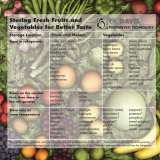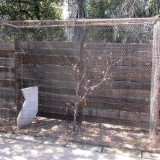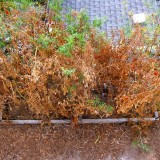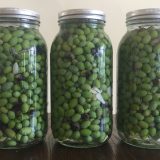
Last October I started curing the olives from the Frantoio tree we planted in the parkway. The olives are finally ready to eat just in time for the pandemic. I used UC Davis’ handy publication, Olives: Safe Methods for Home Pickling as my guide and chose a Sicilian style brine method that yields a slightly bitter result. Basically, you make a brine solution with pickling salt (one pound salt per gallon of water) and vinegar (5% acetic acid–1 1/2 cups per gallon). To this I added some garlic and hot pepper flakes. I went light on the seasoning which, I think, was a good idea. Following the suggestion on the Hunter Angler Gardener Cook blog I changed out the brine when the water darkened—about once a month.

What the olives looked like at the beginning of the curing process.
The verdict: harvesting and curing olives is a lot of work but well worth the effort. It took six months of curing to leach out the bitter phenolic compounds in the fruit.
Some things I learned in the process:
- Here in Southern California, where we have a plague of olive fruit flies, you need to set a McPhail trap baited with torula yeast lures and change out the bait once a month. I set a reminder on my calendar to do this.
- When you harvest you need to separate the maggot infested fruit from the good fruit. This is easy to do if a bit of a chore. The signs of maggots are obvious–a scar on the surface of the fruit.
- You can harvest both green and the more mature black olives from the same tree and cure them both together. Olives are ready to pick when the juice is cloudy in late September. I have to error on the side of picking early to stay ahead of the maggots.
- I planted the tree in 2012 and I’d guess that 2018 was probably the first year that I would have had enough olives to make it worth curing. The tree really exploded, in terms of growth, after about three years in the ground and I’d guess it’s around fifteen feet tall and ten feet wide as of 2020. If I had to choose a tree again I might go with one that produces larger fruit. That said, I’m still happy with the results of this multi-year experiment.
I should also note that the tree itself is beautiful, especially when the silvery underside of the leaves shimmer in a light breeze. Olive trees have deep symbolic associations in ancient Mediterranean cultures and the tree has an average lifespan of 500 years. There are a few trees, over 2,000 years old, that still produce fruit.
If you live in the U.S. but not in a climate that supports olives, consider buying domestic olive oil and cured olives. Especially with olive oil, a lot of the imported stuff is adulterated garbage.





Last year a Portuguese friend taught me to cure olives. He has his own trees here in Northern California. A little work every now and again but totally worth it.
Hi, I have always wanted to do this. I see thousands of olive trees with fruit just wasting away on the ground. This was a truly inspiring post. I would like to plant a tree, but I am unsure how long I will be at this residence and all trees must be approved by our association. Regulation here in Riverside water problems. Thank you.
This is great, thanks for sharing! A bit of jealousy coming from this non-Mediterranean climate dweller.
That is a really cool update. Always nice when these long-term projects actually work out.
Wow, there really must be a lot to Olives, the ancient Greek majestic trees. If only we had warmer climate over here, but maybe. Medlars, Olives, Damsons, my to do list just grows everyday as discover something new. Great post. Godbless.